Comprehensive Analysis of Premenstrual Syndrome: Causes and Therapies
VerifiedAdded on 2023/06/07
|7
|1648
|114
Report
AI Summary
This report provides a comprehensive overview of Premenstrual Syndrome (PMS), detailing its pathophysiology, common causes, and available therapies. It explains how hormonal fluctuations after ovulation trigger PMS, affecting neurotransmitter systems and leading to various symptoms like mood changes, irritability, and physical discomfort. The report differentiates PMS from Polycystic Ovary Syndrome (PCOS) by highlighting differences in clinical manifestations, symptom timing, and impact on fertility and quality of life. Common therapies for PMS, including SSRIs, hormonal contraceptives, and lifestyle changes such as exercise, dietary adjustments, and smoking cessation, are discussed to help manage symptoms effectively. The document concludes with a list of references used to compile the information.
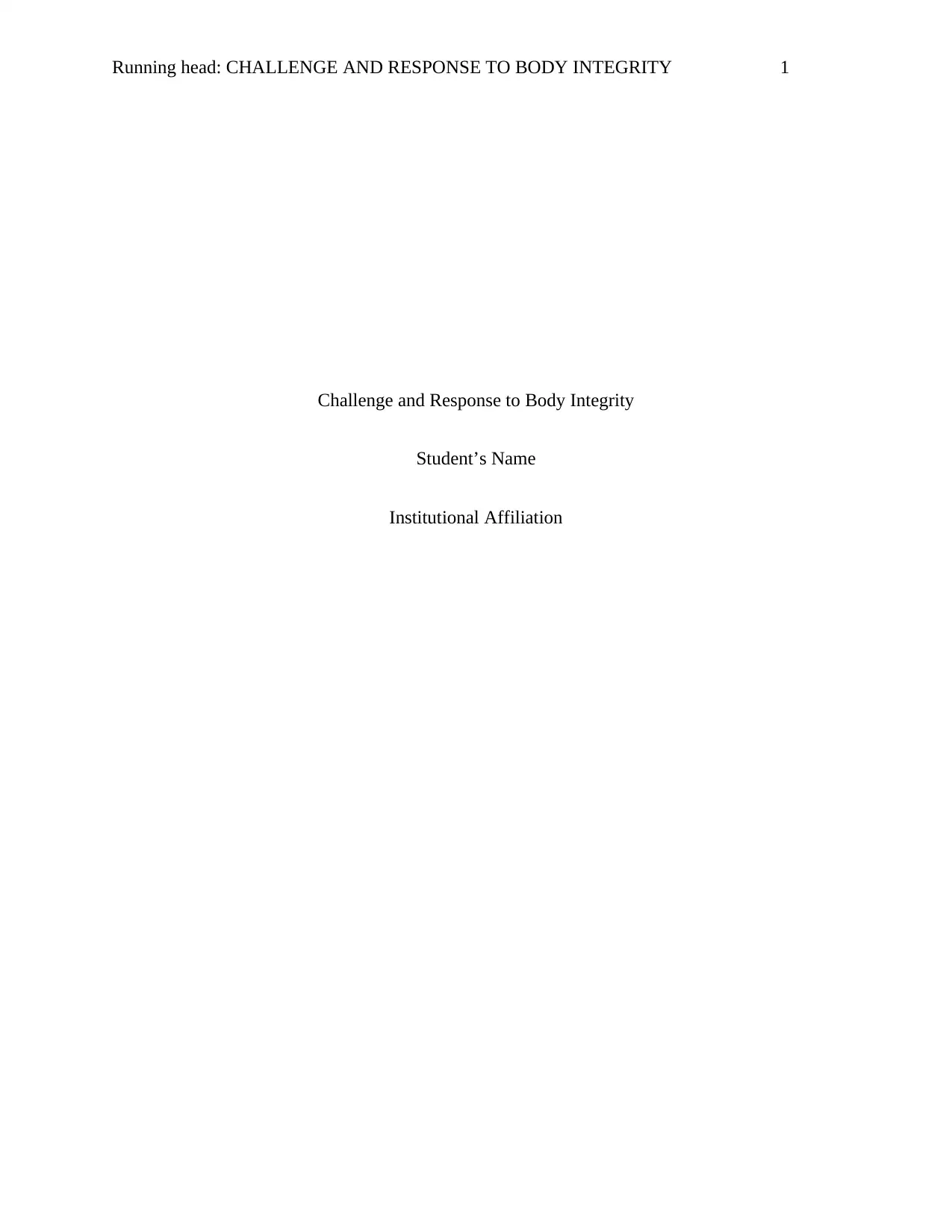
Running head: CHALLENGE AND RESPONSE TO BODY INTEGRITY 1
Challenge and Response to Body Integrity
Student’s Name
Institutional Affiliation
Challenge and Response to Body Integrity
Student’s Name
Institutional Affiliation
Paraphrase This Document
Need a fresh take? Get an instant paraphrase of this document with our AI Paraphraser
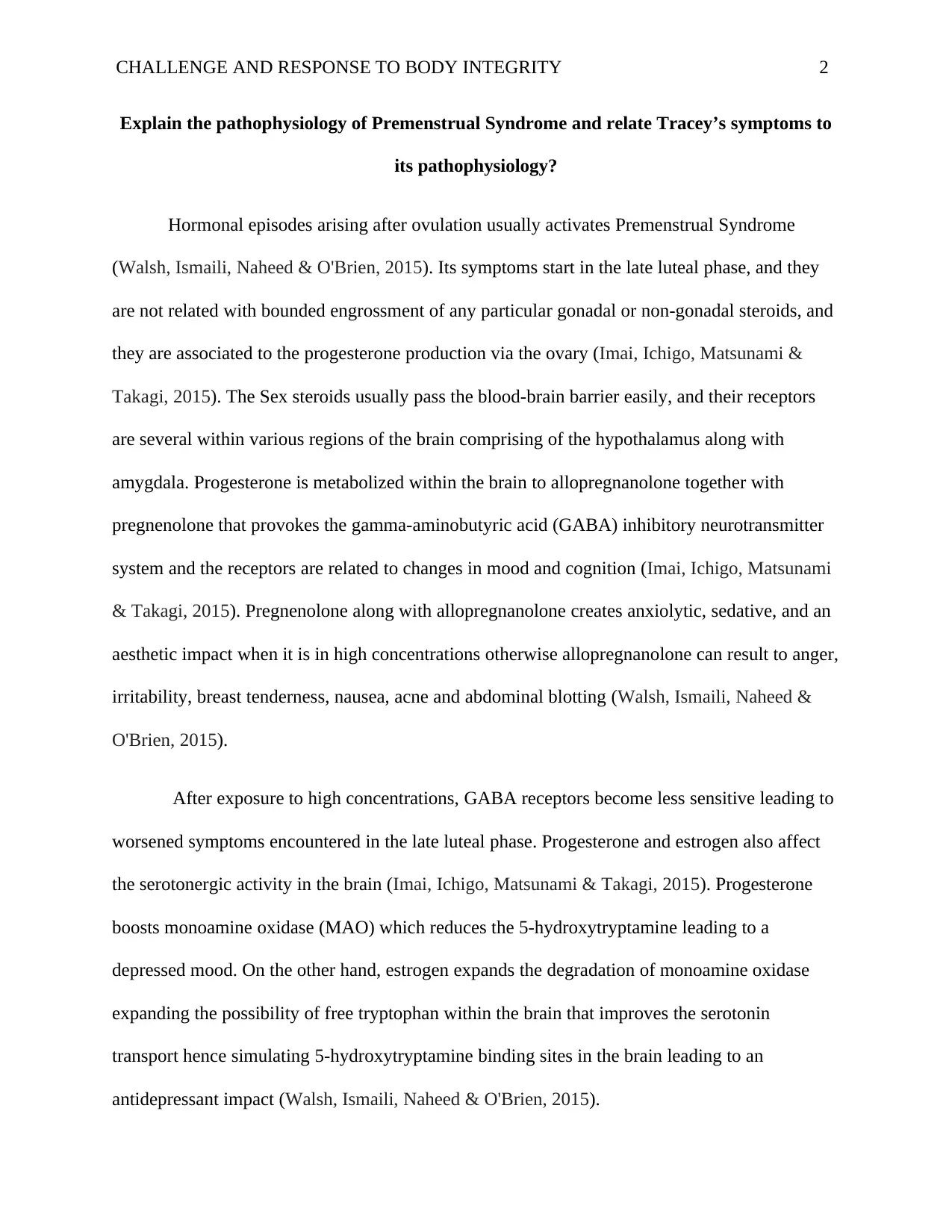
CHALLENGE AND RESPONSE TO BODY INTEGRITY 2
Explain the pathophysiology of Premenstrual Syndrome and relate Tracey’s symptoms to
its pathophysiology?
Hormonal episodes arising after ovulation usually activates Premenstrual Syndrome
(Walsh, Ismaili, Naheed & O'Brien, 2015). Its symptoms start in the late luteal phase, and they
are not related with bounded engrossment of any particular gonadal or non-gonadal steroids, and
they are associated to the progesterone production via the ovary (Imai, Ichigo, Matsunami &
Takagi, 2015). The Sex steroids usually pass the blood-brain barrier easily, and their receptors
are several within various regions of the brain comprising of the hypothalamus along with
amygdala. Progesterone is metabolized within the brain to allopregnanolone together with
pregnenolone that provokes the gamma-aminobutyric acid (GABA) inhibitory neurotransmitter
system and the receptors are related to changes in mood and cognition (Imai, Ichigo, Matsunami
& Takagi, 2015). Pregnenolone along with allopregnanolone creates anxiolytic, sedative, and an
aesthetic impact when it is in high concentrations otherwise allopregnanolone can result to anger,
irritability, breast tenderness, nausea, acne and abdominal blotting (Walsh, Ismaili, Naheed &
O'Brien, 2015).
After exposure to high concentrations, GABA receptors become less sensitive leading to
worsened symptoms encountered in the late luteal phase. Progesterone and estrogen also affect
the serotonergic activity in the brain (Imai, Ichigo, Matsunami & Takagi, 2015). Progesterone
boosts monoamine oxidase (MAO) which reduces the 5-hydroxytryptamine leading to a
depressed mood. On the other hand, estrogen expands the degradation of monoamine oxidase
expanding the possibility of free tryptophan within the brain that improves the serotonin
transport hence simulating 5-hydroxytryptamine binding sites in the brain leading to an
antidepressant impact (Walsh, Ismaili, Naheed & O'Brien, 2015).
Explain the pathophysiology of Premenstrual Syndrome and relate Tracey’s symptoms to
its pathophysiology?
Hormonal episodes arising after ovulation usually activates Premenstrual Syndrome
(Walsh, Ismaili, Naheed & O'Brien, 2015). Its symptoms start in the late luteal phase, and they
are not related with bounded engrossment of any particular gonadal or non-gonadal steroids, and
they are associated to the progesterone production via the ovary (Imai, Ichigo, Matsunami &
Takagi, 2015). The Sex steroids usually pass the blood-brain barrier easily, and their receptors
are several within various regions of the brain comprising of the hypothalamus along with
amygdala. Progesterone is metabolized within the brain to allopregnanolone together with
pregnenolone that provokes the gamma-aminobutyric acid (GABA) inhibitory neurotransmitter
system and the receptors are related to changes in mood and cognition (Imai, Ichigo, Matsunami
& Takagi, 2015). Pregnenolone along with allopregnanolone creates anxiolytic, sedative, and an
aesthetic impact when it is in high concentrations otherwise allopregnanolone can result to anger,
irritability, breast tenderness, nausea, acne and abdominal blotting (Walsh, Ismaili, Naheed &
O'Brien, 2015).
After exposure to high concentrations, GABA receptors become less sensitive leading to
worsened symptoms encountered in the late luteal phase. Progesterone and estrogen also affect
the serotonergic activity in the brain (Imai, Ichigo, Matsunami & Takagi, 2015). Progesterone
boosts monoamine oxidase (MAO) which reduces the 5-hydroxytryptamine leading to a
depressed mood. On the other hand, estrogen expands the degradation of monoamine oxidase
expanding the possibility of free tryptophan within the brain that improves the serotonin
transport hence simulating 5-hydroxytryptamine binding sites in the brain leading to an
antidepressant impact (Walsh, Ismaili, Naheed & O'Brien, 2015).
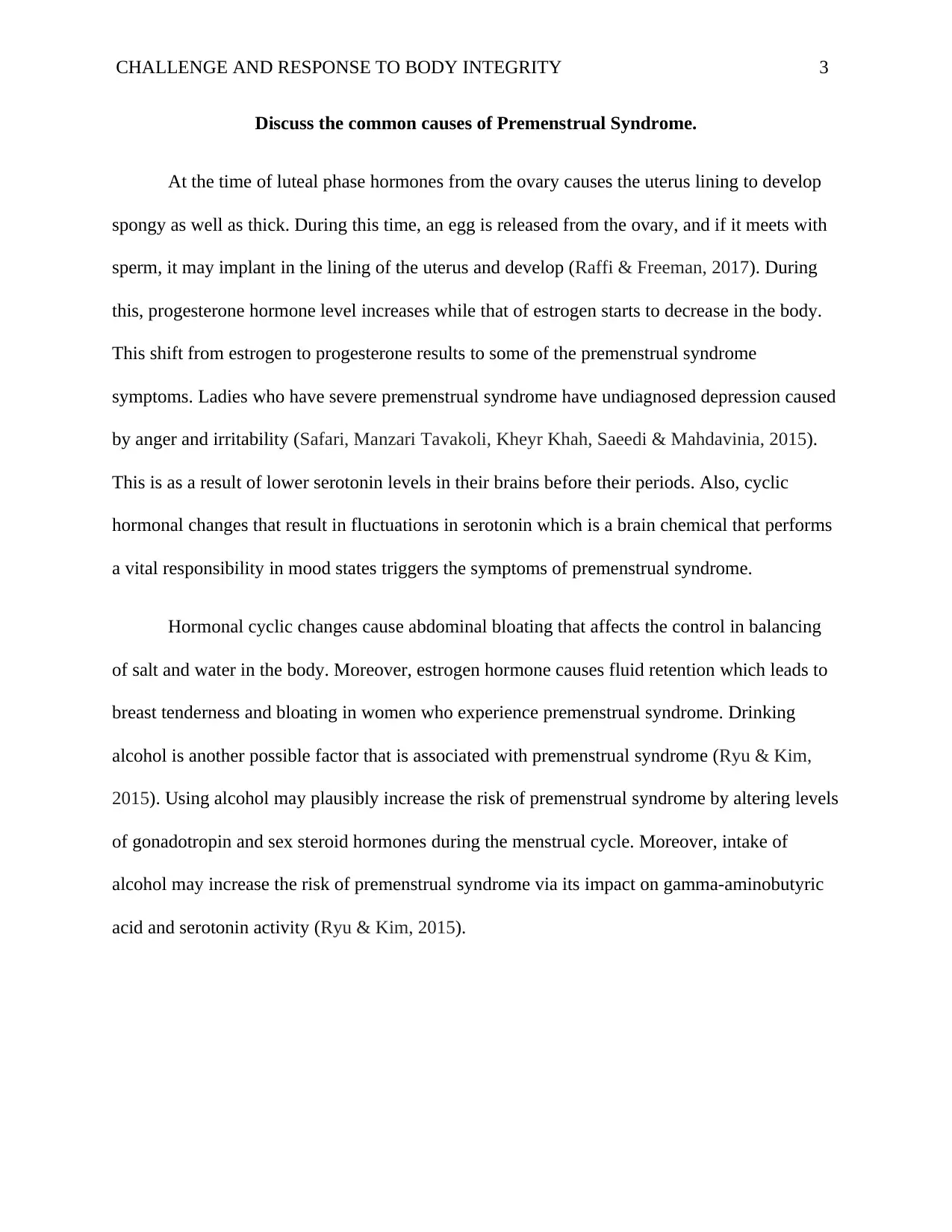
CHALLENGE AND RESPONSE TO BODY INTEGRITY 3
Discuss the common causes of Premenstrual Syndrome.
At the time of luteal phase hormones from the ovary causes the uterus lining to develop
spongy as well as thick. During this time, an egg is released from the ovary, and if it meets with
sperm, it may implant in the lining of the uterus and develop (Raffi & Freeman, 2017). During
this, progesterone hormone level increases while that of estrogen starts to decrease in the body.
This shift from estrogen to progesterone results to some of the premenstrual syndrome
symptoms. Ladies who have severe premenstrual syndrome have undiagnosed depression caused
by anger and irritability (Safari, Manzari Tavakoli, Kheyr Khah, Saeedi & Mahdavinia, 2015).
This is as a result of lower serotonin levels in their brains before their periods. Also, cyclic
hormonal changes that result in fluctuations in serotonin which is a brain chemical that performs
a vital responsibility in mood states triggers the symptoms of premenstrual syndrome.
Hormonal cyclic changes cause abdominal bloating that affects the control in balancing
of salt and water in the body. Moreover, estrogen hormone causes fluid retention which leads to
breast tenderness and bloating in women who experience premenstrual syndrome. Drinking
alcohol is another possible factor that is associated with premenstrual syndrome (Ryu & Kim,
2015). Using alcohol may plausibly increase the risk of premenstrual syndrome by altering levels
of gonadotropin and sex steroid hormones during the menstrual cycle. Moreover, intake of
alcohol may increase the risk of premenstrual syndrome via its impact on gamma-aminobutyric
acid and serotonin activity (Ryu & Kim, 2015).
Discuss the common causes of Premenstrual Syndrome.
At the time of luteal phase hormones from the ovary causes the uterus lining to develop
spongy as well as thick. During this time, an egg is released from the ovary, and if it meets with
sperm, it may implant in the lining of the uterus and develop (Raffi & Freeman, 2017). During
this, progesterone hormone level increases while that of estrogen starts to decrease in the body.
This shift from estrogen to progesterone results to some of the premenstrual syndrome
symptoms. Ladies who have severe premenstrual syndrome have undiagnosed depression caused
by anger and irritability (Safari, Manzari Tavakoli, Kheyr Khah, Saeedi & Mahdavinia, 2015).
This is as a result of lower serotonin levels in their brains before their periods. Also, cyclic
hormonal changes that result in fluctuations in serotonin which is a brain chemical that performs
a vital responsibility in mood states triggers the symptoms of premenstrual syndrome.
Hormonal cyclic changes cause abdominal bloating that affects the control in balancing
of salt and water in the body. Moreover, estrogen hormone causes fluid retention which leads to
breast tenderness and bloating in women who experience premenstrual syndrome. Drinking
alcohol is another possible factor that is associated with premenstrual syndrome (Ryu & Kim,
2015). Using alcohol may plausibly increase the risk of premenstrual syndrome by altering levels
of gonadotropin and sex steroid hormones during the menstrual cycle. Moreover, intake of
alcohol may increase the risk of premenstrual syndrome via its impact on gamma-aminobutyric
acid and serotonin activity (Ryu & Kim, 2015).
⊘ This is a preview!⊘
Do you want full access?
Subscribe today to unlock all pages.

Trusted by 1+ million students worldwide
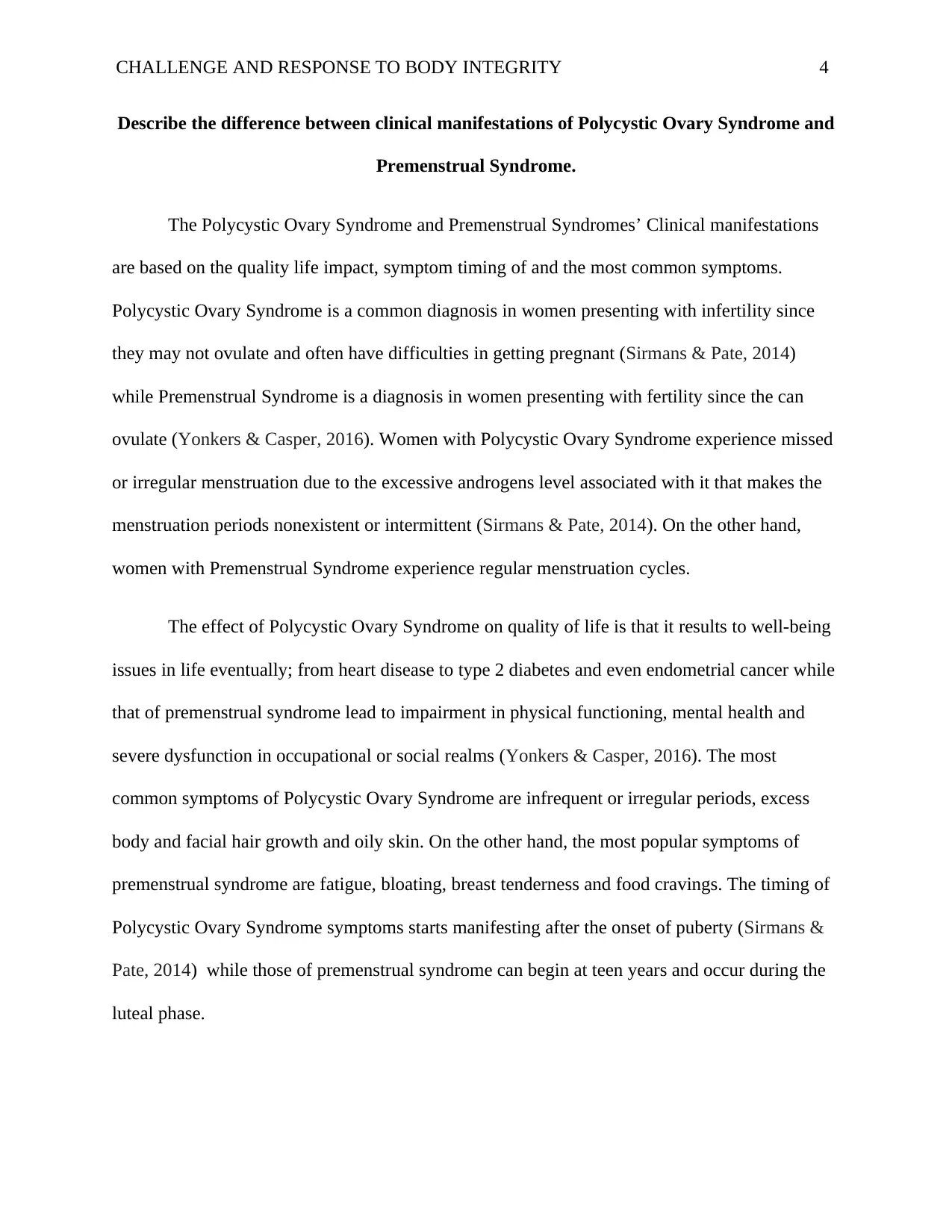
CHALLENGE AND RESPONSE TO BODY INTEGRITY 4
Describe the difference between clinical manifestations of Polycystic Ovary Syndrome and
Premenstrual Syndrome.
The Polycystic Ovary Syndrome and Premenstrual Syndromes’ Clinical manifestations
are based on the quality life impact, symptom timing of and the most common symptoms.
Polycystic Ovary Syndrome is a common diagnosis in women presenting with infertility since
they may not ovulate and often have difficulties in getting pregnant (Sirmans & Pate, 2014)
while Premenstrual Syndrome is a diagnosis in women presenting with fertility since the can
ovulate (Yonkers & Casper, 2016). Women with Polycystic Ovary Syndrome experience missed
or irregular menstruation due to the excessive androgens level associated with it that makes the
menstruation periods nonexistent or intermittent (Sirmans & Pate, 2014). On the other hand,
women with Premenstrual Syndrome experience regular menstruation cycles.
The effect of Polycystic Ovary Syndrome on quality of life is that it results to well-being
issues in life eventually; from heart disease to type 2 diabetes and even endometrial cancer while
that of premenstrual syndrome lead to impairment in physical functioning, mental health and
severe dysfunction in occupational or social realms (Yonkers & Casper, 2016). The most
common symptoms of Polycystic Ovary Syndrome are infrequent or irregular periods, excess
body and facial hair growth and oily skin. On the other hand, the most popular symptoms of
premenstrual syndrome are fatigue, bloating, breast tenderness and food cravings. The timing of
Polycystic Ovary Syndrome symptoms starts manifesting after the onset of puberty (Sirmans &
Pate, 2014) while those of premenstrual syndrome can begin at teen years and occur during the
luteal phase.
Describe the difference between clinical manifestations of Polycystic Ovary Syndrome and
Premenstrual Syndrome.
The Polycystic Ovary Syndrome and Premenstrual Syndromes’ Clinical manifestations
are based on the quality life impact, symptom timing of and the most common symptoms.
Polycystic Ovary Syndrome is a common diagnosis in women presenting with infertility since
they may not ovulate and often have difficulties in getting pregnant (Sirmans & Pate, 2014)
while Premenstrual Syndrome is a diagnosis in women presenting with fertility since the can
ovulate (Yonkers & Casper, 2016). Women with Polycystic Ovary Syndrome experience missed
or irregular menstruation due to the excessive androgens level associated with it that makes the
menstruation periods nonexistent or intermittent (Sirmans & Pate, 2014). On the other hand,
women with Premenstrual Syndrome experience regular menstruation cycles.
The effect of Polycystic Ovary Syndrome on quality of life is that it results to well-being
issues in life eventually; from heart disease to type 2 diabetes and even endometrial cancer while
that of premenstrual syndrome lead to impairment in physical functioning, mental health and
severe dysfunction in occupational or social realms (Yonkers & Casper, 2016). The most
common symptoms of Polycystic Ovary Syndrome are infrequent or irregular periods, excess
body and facial hair growth and oily skin. On the other hand, the most popular symptoms of
premenstrual syndrome are fatigue, bloating, breast tenderness and food cravings. The timing of
Polycystic Ovary Syndrome symptoms starts manifesting after the onset of puberty (Sirmans &
Pate, 2014) while those of premenstrual syndrome can begin at teen years and occur during the
luteal phase.
Paraphrase This Document
Need a fresh take? Get an instant paraphrase of this document with our AI Paraphraser
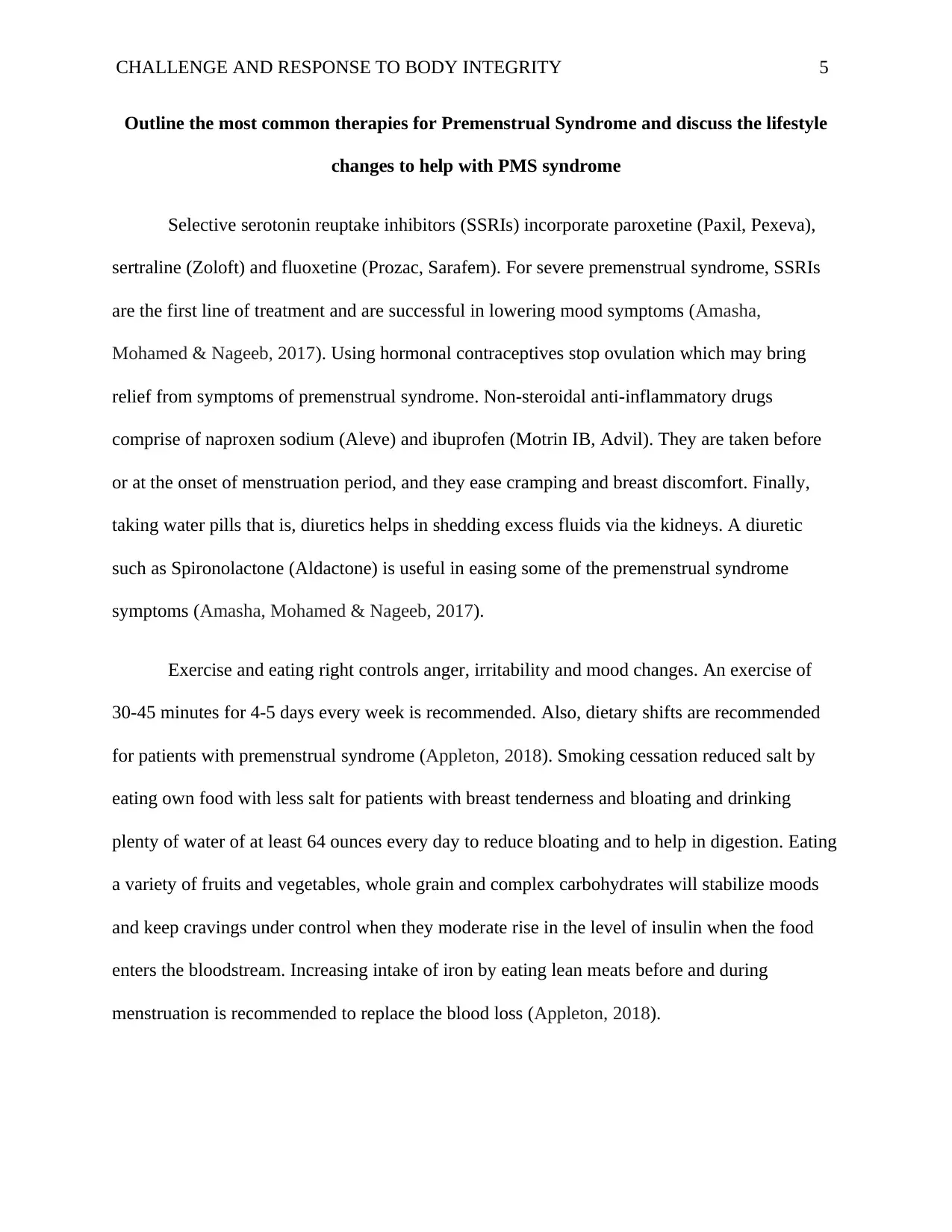
CHALLENGE AND RESPONSE TO BODY INTEGRITY 5
Outline the most common therapies for Premenstrual Syndrome and discuss the lifestyle
changes to help with PMS syndrome
Selective serotonin reuptake inhibitors (SSRIs) incorporate paroxetine (Paxil, Pexeva),
sertraline (Zoloft) and fluoxetine (Prozac, Sarafem). For severe premenstrual syndrome, SSRIs
are the first line of treatment and are successful in lowering mood symptoms (Amasha,
Mohamed & Nageeb, 2017). Using hormonal contraceptives stop ovulation which may bring
relief from symptoms of premenstrual syndrome. Non-steroidal anti-inflammatory drugs
comprise of naproxen sodium (Aleve) and ibuprofen (Motrin IB, Advil). They are taken before
or at the onset of menstruation period, and they ease cramping and breast discomfort. Finally,
taking water pills that is, diuretics helps in shedding excess fluids via the kidneys. A diuretic
such as Spironolactone (Aldactone) is useful in easing some of the premenstrual syndrome
symptoms (Amasha, Mohamed & Nageeb, 2017).
Exercise and eating right controls anger, irritability and mood changes. An exercise of
30-45 minutes for 4-5 days every week is recommended. Also, dietary shifts are recommended
for patients with premenstrual syndrome (Appleton, 2018). Smoking cessation reduced salt by
eating own food with less salt for patients with breast tenderness and bloating and drinking
plenty of water of at least 64 ounces every day to reduce bloating and to help in digestion. Eating
a variety of fruits and vegetables, whole grain and complex carbohydrates will stabilize moods
and keep cravings under control when they moderate rise in the level of insulin when the food
enters the bloodstream. Increasing intake of iron by eating lean meats before and during
menstruation is recommended to replace the blood loss (Appleton, 2018).
Outline the most common therapies for Premenstrual Syndrome and discuss the lifestyle
changes to help with PMS syndrome
Selective serotonin reuptake inhibitors (SSRIs) incorporate paroxetine (Paxil, Pexeva),
sertraline (Zoloft) and fluoxetine (Prozac, Sarafem). For severe premenstrual syndrome, SSRIs
are the first line of treatment and are successful in lowering mood symptoms (Amasha,
Mohamed & Nageeb, 2017). Using hormonal contraceptives stop ovulation which may bring
relief from symptoms of premenstrual syndrome. Non-steroidal anti-inflammatory drugs
comprise of naproxen sodium (Aleve) and ibuprofen (Motrin IB, Advil). They are taken before
or at the onset of menstruation period, and they ease cramping and breast discomfort. Finally,
taking water pills that is, diuretics helps in shedding excess fluids via the kidneys. A diuretic
such as Spironolactone (Aldactone) is useful in easing some of the premenstrual syndrome
symptoms (Amasha, Mohamed & Nageeb, 2017).
Exercise and eating right controls anger, irritability and mood changes. An exercise of
30-45 minutes for 4-5 days every week is recommended. Also, dietary shifts are recommended
for patients with premenstrual syndrome (Appleton, 2018). Smoking cessation reduced salt by
eating own food with less salt for patients with breast tenderness and bloating and drinking
plenty of water of at least 64 ounces every day to reduce bloating and to help in digestion. Eating
a variety of fruits and vegetables, whole grain and complex carbohydrates will stabilize moods
and keep cravings under control when they moderate rise in the level of insulin when the food
enters the bloodstream. Increasing intake of iron by eating lean meats before and during
menstruation is recommended to replace the blood loss (Appleton, 2018).
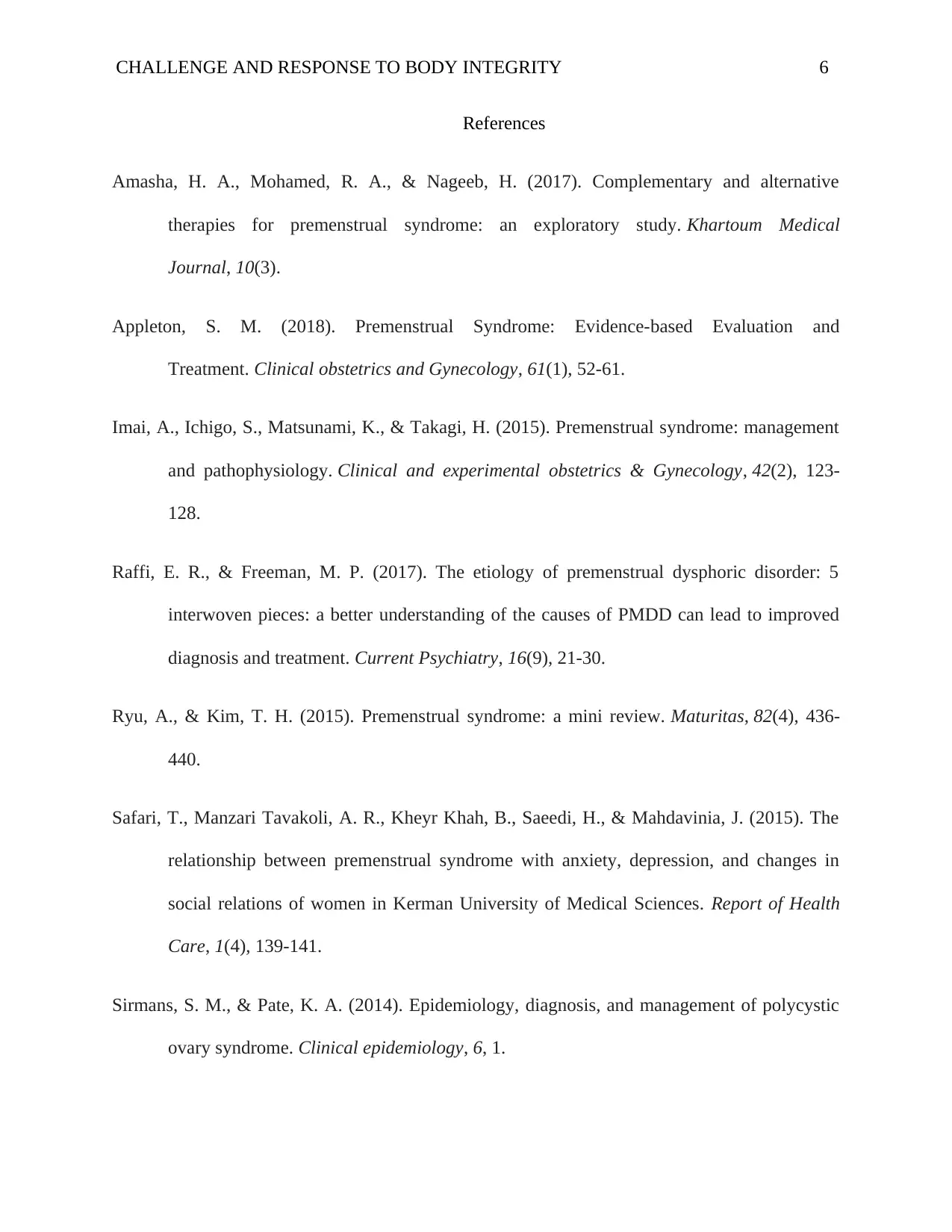
CHALLENGE AND RESPONSE TO BODY INTEGRITY 6
References
Amasha, H. A., Mohamed, R. A., & Nageeb, H. (2017). Complementary and alternative
therapies for premenstrual syndrome: an exploratory study. Khartoum Medical
Journal, 10(3).
Appleton, S. M. (2018). Premenstrual Syndrome: Evidence-based Evaluation and
Treatment. Clinical obstetrics and Gynecology, 61(1), 52-61.
Imai, A., Ichigo, S., Matsunami, K., & Takagi, H. (2015). Premenstrual syndrome: management
and pathophysiology. Clinical and experimental obstetrics & Gynecology, 42(2), 123-
128.
Raffi, E. R., & Freeman, M. P. (2017). The etiology of premenstrual dysphoric disorder: 5
interwoven pieces: a better understanding of the causes of PMDD can lead to improved
diagnosis and treatment. Current Psychiatry, 16(9), 21-30.
Ryu, A., & Kim, T. H. (2015). Premenstrual syndrome: a mini review. Maturitas, 82(4), 436-
440.
Safari, T., Manzari Tavakoli, A. R., Kheyr Khah, B., Saeedi, H., & Mahdavinia, J. (2015). The
relationship between premenstrual syndrome with anxiety, depression, and changes in
social relations of women in Kerman University of Medical Sciences. Report of Health
Care, 1(4), 139-141.
Sirmans, S. M., & Pate, K. A. (2014). Epidemiology, diagnosis, and management of polycystic
ovary syndrome. Clinical epidemiology, 6, 1.
References
Amasha, H. A., Mohamed, R. A., & Nageeb, H. (2017). Complementary and alternative
therapies for premenstrual syndrome: an exploratory study. Khartoum Medical
Journal, 10(3).
Appleton, S. M. (2018). Premenstrual Syndrome: Evidence-based Evaluation and
Treatment. Clinical obstetrics and Gynecology, 61(1), 52-61.
Imai, A., Ichigo, S., Matsunami, K., & Takagi, H. (2015). Premenstrual syndrome: management
and pathophysiology. Clinical and experimental obstetrics & Gynecology, 42(2), 123-
128.
Raffi, E. R., & Freeman, M. P. (2017). The etiology of premenstrual dysphoric disorder: 5
interwoven pieces: a better understanding of the causes of PMDD can lead to improved
diagnosis and treatment. Current Psychiatry, 16(9), 21-30.
Ryu, A., & Kim, T. H. (2015). Premenstrual syndrome: a mini review. Maturitas, 82(4), 436-
440.
Safari, T., Manzari Tavakoli, A. R., Kheyr Khah, B., Saeedi, H., & Mahdavinia, J. (2015). The
relationship between premenstrual syndrome with anxiety, depression, and changes in
social relations of women in Kerman University of Medical Sciences. Report of Health
Care, 1(4), 139-141.
Sirmans, S. M., & Pate, K. A. (2014). Epidemiology, diagnosis, and management of polycystic
ovary syndrome. Clinical epidemiology, 6, 1.
⊘ This is a preview!⊘
Do you want full access?
Subscribe today to unlock all pages.

Trusted by 1+ million students worldwide
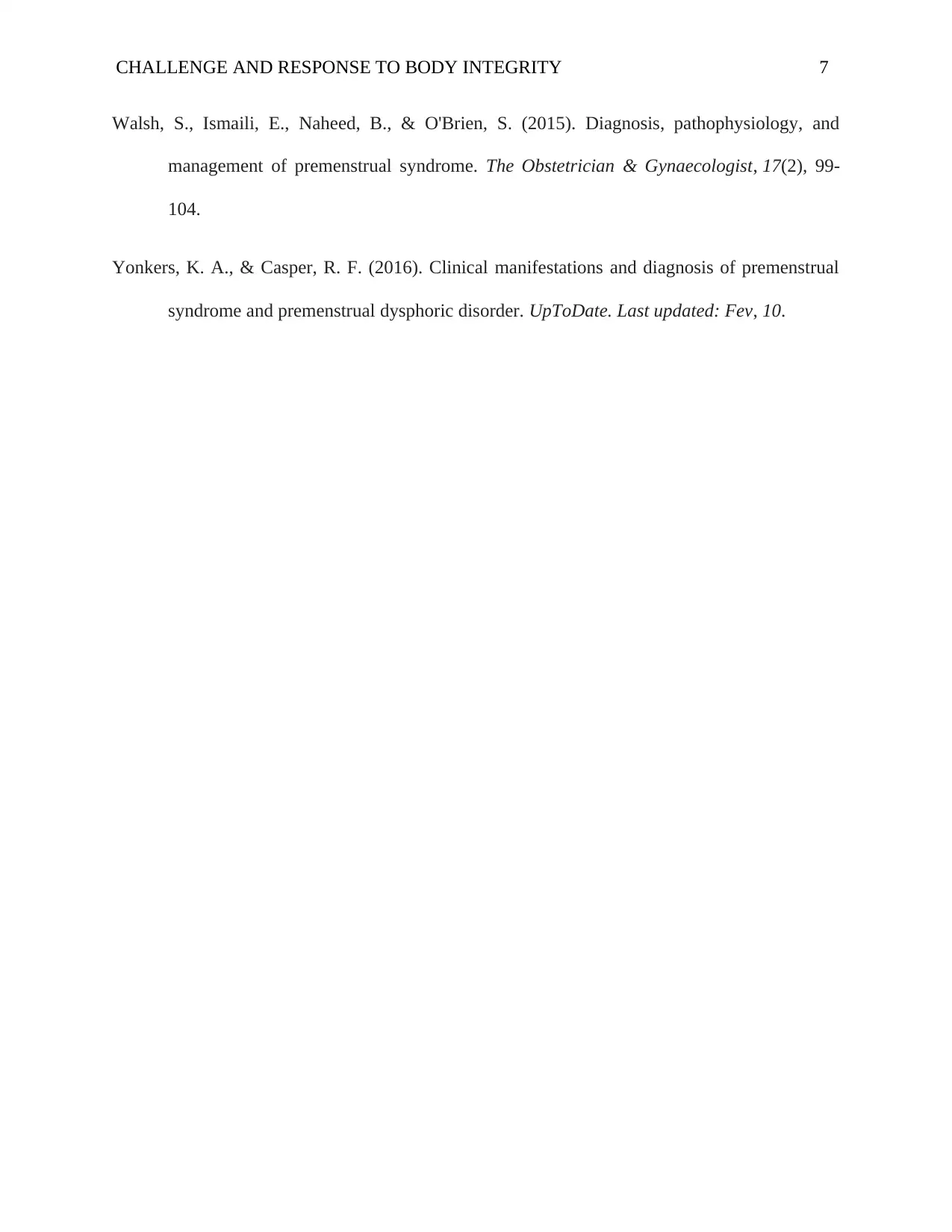
CHALLENGE AND RESPONSE TO BODY INTEGRITY 7
Walsh, S., Ismaili, E., Naheed, B., & O'Brien, S. (2015). Diagnosis, pathophysiology, and
management of premenstrual syndrome. The Obstetrician & Gynaecologist, 17(2), 99-
104.
Yonkers, K. A., & Casper, R. F. (2016). Clinical manifestations and diagnosis of premenstrual
syndrome and premenstrual dysphoric disorder. UpToDate. Last updated: Fev, 10.
Walsh, S., Ismaili, E., Naheed, B., & O'Brien, S. (2015). Diagnosis, pathophysiology, and
management of premenstrual syndrome. The Obstetrician & Gynaecologist, 17(2), 99-
104.
Yonkers, K. A., & Casper, R. F. (2016). Clinical manifestations and diagnosis of premenstrual
syndrome and premenstrual dysphoric disorder. UpToDate. Last updated: Fev, 10.
1 out of 7
Related Documents
Your All-in-One AI-Powered Toolkit for Academic Success.
+13062052269
info@desklib.com
Available 24*7 on WhatsApp / Email
![[object Object]](/_next/static/media/star-bottom.7253800d.svg)
Unlock your academic potential
Copyright © 2020–2025 A2Z Services. All Rights Reserved. Developed and managed by ZUCOL.



